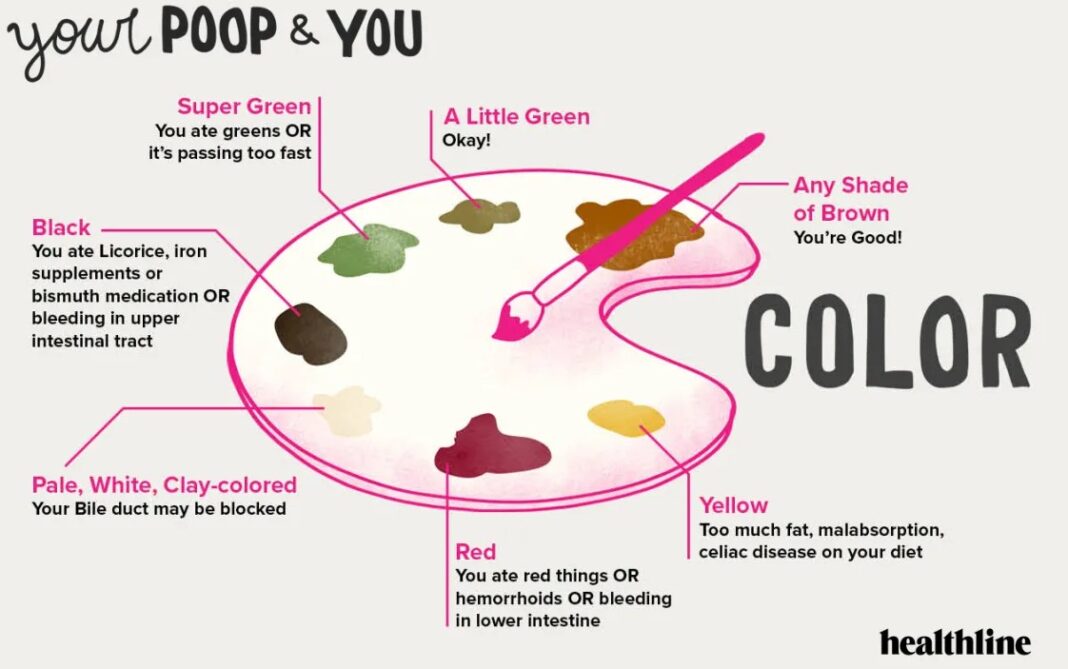BOURSESSENEGAL – The poop color chart serves as a valuable tool for understanding what your stool color might indicate about your health. While it’s not a topic people often discuss, the color of your poop can provide essential insights into your digestive system and overall well-being. In this blog post, we will explore the poop color chart, what different colors mean, and when you should seek medical advice.
What is the Poop Color Chart?
The poop color chart is a visual guide that categorizes stool colors and their potential health implications. Each color can signify various dietary factors, hydration levels, and medical conditions. Understanding these colors helps you identify any changes in your health that may require attention.
Why is Stool Color Important?
Stool color matters because it can reflect how well your digestive system functions. Normal stool typically varies from light brown to dark brown. However, deviations from this range can indicate underlying issues. Recognizing these changes early can lead to timely interventions.
The Poop Color Chart Explained
1. Brown: The Standard Color
Brown stool is what most people expect to see. This color results from bile, which your liver produces. When you digest food, bile interacts with the food and turns brown as it breaks down. If your stool is consistently brown, it generally indicates a healthy digestive system.
2. Green: What Does It Mean?
Green stool can result from several factors:
- Diet: Eating green foods, like spinach or kale, can lead to green poop.
- Bile: If food moves too quickly through the intestines, it may not have time to turn brown, resulting in green stool.
- Infections: Some infections can cause diarrhea, leading to green stool.
If you notice a temporary change to green, it’s usually not a cause for concern. However, persistent green stool may warrant further investigation.
3. Yellow: Potential Issues
Yellow stool can indicate several conditions, including:
- Fat malabsorption: If your body isn’t absorbing fats properly, you might see yellow, greasy stools.
- Diet: A diet high in certain foods, like carrots, can also lead to yellow poop.
If yellow stool persists, consider consulting a healthcare provider to rule out any underlying issues.
4. Red: Blood in the Stool
Red stool can be alarming. It can signify:
- Hemorrhoids: Bright red blood may come from hemorrhoids or anal fissures.
- Gastrointestinal bleeding: Dark red or maroon stools can indicate bleeding higher in the digestive tract.
If you notice red stool, especially if it’s accompanied by other symptoms like pain or weakness, seek medical attention immediately.
5. Black: A Sign of Concern
Black stool can indicate serious issues, including:
- Internal bleeding: This could signify bleeding in the upper gastrointestinal tract, such as from an ulcer.
- Iron supplements: Taking iron supplements can also lead to black stool.
If you see black stool, especially if it’s sudden and accompanied by other concerning symptoms, contact a healthcare professional promptly.
6. Gray or Pale: Liver Problems
Gray or pale stools can suggest:
- Bile duct obstruction: A lack of bile in the stool may indicate a blockage in the bile duct.
- Liver issues: Conditions affecting the liver can also lead to pale stools.
If you experience gray or pale stools consistently, seek medical evaluation as soon as possible.
Factors Influencing Stool Color
1. Diet
Diet plays a significant role in stool color. Foods rich in certain pigments can change the color of your poop. For example:
- Beets can turn stool reddish.
- Carrots may lead to a yellowish hue.
2. Hydration
Hydration affects your stool’s consistency and color. Dehydration can result in harder, darker stools. Staying well-hydrated helps maintain healthy digestion.
3. Medications
Certain medications and supplements can impact stool color. For instance, antibiotics can lead to green or yellow stool, while iron supplements can darken it. Always discuss potential side effects with your healthcare provider.
When to Seek Medical Attention
1. Persistent Changes
If you notice persistent changes in stool color that last more than a few days, consider consulting a healthcare professional. Early intervention can prevent potential health issues.
2. Accompanying Symptoms
If changes in stool color occur alongside other symptoms, such as abdominal pain, fever, or weight loss, it’s crucial to seek medical advice. These signs may indicate a more serious condition.
3. Frequent Diarrhea or Constipation
Frequent changes between diarrhea and constipation, along with color changes, could suggest a digestive disorder. Keep track of your symptoms and share them with your healthcare provider.
How to Use the Poop Color Chart
1. Self-Monitoring
Use the poop color chart as a guide for self-monitoring your stool. Observe any changes and take note of accompanying factors like diet and hydration.
2. Record Keeping
Keeping a journal of your bowel movements can help you identify patterns and changes over time. This information can be valuable when discussing concerns with your healthcare provider.
3. Consult Professionals
If you notice concerning changes, don’t hesitate to reach out to healthcare professionals. They can provide guidance and necessary tests to determine the cause of any issues.
Conclusion: The Importance of Paying Attention to Stool Color
The poop color chart serves as an important tool for understanding your digestive health. While many color variations may not indicate serious problems, recognizing changes is essential. By paying attention to your stool color, diet, hydration, and any accompanying symptoms, you can better manage your health.
Remember, your body communicates with you in many ways, and stool color is just one aspect. Stay informed, take charge of your health, and don’t hesitate to seek help when needed. Keeping track of these changes can empower you to make better choices for your well-being.
REFERENCE : ran303



